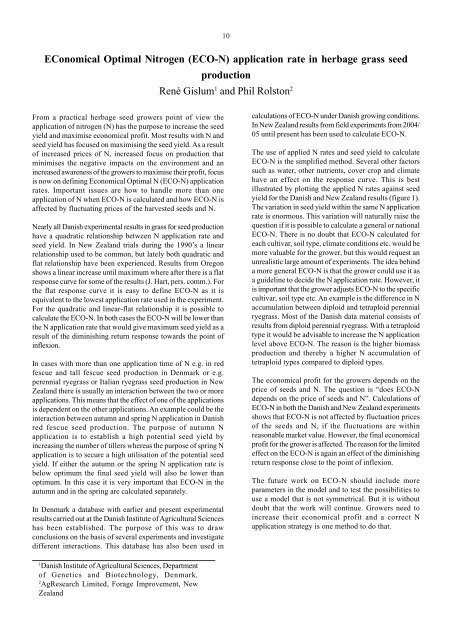6th IHSG Conference - International Herbage Seed Group
6th IHSG Conference - International Herbage Seed Group
6th IHSG Conference - International Herbage Seed Group
- No tags were found...
You also want an ePaper? Increase the reach of your titles
YUMPU automatically turns print PDFs into web optimized ePapers that Google loves.
10EConomical Optimal Nitrogen (ECO-N) application rate in herbage grass seedproductionRené Gislum 1 and Phil Rolston 2From a practical herbage seed growers point of view theapplication of nitrogen (N) has the purpose to increase the seedyield and maximise economical profit. Most results with N andseed yield has focused on maximising the seed yield. As a resultof increased prices of N, increased focus on production thatminimises the negative impacts on the environment and anincreased awareness of the growers to maximise their profit, focusis now on defining Economical Optimal N (ECO-N) applicationrates. Important issues are how to handle more than oneapplication of N when ECO-N is calculated and how ECO-N isaffected by fluctuating prices of the harvested seeds and N.Nearly all Danish experimental results in grass for seed productionhave a quadratic relationship between N application rate andseed yield. In New Zealand trials during the 1990’s a linearrelationship used to be common, but lately both quadratic andflat relationship have been experienced. Results from Oregonshows a linear increase until maximum where after there is a flatresponse curve for some of the results (J. Hart, pers. comm.). Forthe flat response curve it is easy to define ECO-N as it isequivalent to the lowest application rate used in the experiment.For the quadratic and linear-flat relationship it is possible tocalculate the ECO-N. In both cases the ECO-N will be lower thanthe N application rate that would give maximum seed yield as aresult of the diminishing return response towards the point ofinflexion.In cases with more than one application time of N e.g. in redfescue and tall fescue seed production in Denmark or e.g.perennial ryegrass or Italian ryegrass seed production in NewZealand there is usually an interaction between the two or moreapplications. This means that the effect of one of the applicationsis dependent on the other applications. An example could be theinteraction between autumn and spring N application in Danishred fescue seed production. The purpose of autumn Napplication is to establish a high potential seed yield byincreasing the number of tillers whereas the purpose of spring Napplication is to secure a high utilisation of the potential seedyield. If either the autumn or the spring N application rate isbelow optimum the final seed yield will also be lower thanoptimum. In this case it is very important that ECO-N in theautumn and in the spring are calculated separately.In Denmark a database with earlier and present experimentalresults carried out at the Danish Institute of Agricultural Scienceshas been established. The purpose of this was to drawconclusions on the basis of several experiments and investigatedifferent interactions. This database has also been used incalculations of ECO-N under Danish growing conditions.In New Zealand results from field experiments from 2004/05 until present has been used to calculate ECO-N.The use of applied N rates and seed yield to calculateECO-N is the simplified method. Several other factorssuch as water, other nutrients, cover crop and climatehave an effect on the response curve. This is bestillustrated by plotting the applied N rates against seedyield for the Danish and New Zealand results (figure 1).The variation in seed yield within the same N applicationrate is enormous. This variation will naturally raise thequestion if it is possible to calculate a general or nationalECO-N. There is no doubt that ECO-N calculated foreach cultivar, soil type, climate conditions etc. would bemore valuable for the grower, but this would request anunrealistic large amount of experiments. The idea behinda more general ECO-N is that the grower could use it asa guideline to decide the N application rate. However, itis important that the grower adjusts ECO-N to the specificcultivar, soil type etc. An example is the difference in Naccumulation between diploid and tetraploid perennialryegrass. Most of the Danish data material consists ofresults from diploid perennial ryegrass. With a tetraploidtype it would be advisable to increase the N applicationlevel above ECO-N. The reason is the higher biomassproduction and thereby a higher N accumulation oftetraploid types compared to diploid types.The economical profit for the growers depends on theprice of seeds and N. The question is “does ECO-Ndepends on the price of seeds and N”. Calculations ofECO-N in both the Danish and New Zealand experimentsshows that ECO-N is not affected by fluctuation pricesof the seeds and N, if the fluctuations are withinreasonable market value. However, the final economicalprofit for the grower is affected. The reason for the limitedeffect on the ECO-N is again an effect of the diminishingreturn response close to the point of inflexion.The future work on ECO-N should include moreparameters in the model and to test the possibilities touse a model that is not symmetrical. But it is withoutdoubt that the work will continue. Growers need toincrease their economical profit and a correct Napplication strategy is one method to do that.1Danish Institute of Agricultural Sciences, Departmentof Genetics and Biotechnology, Denmark,2AgResearch Limited, Forage Improvement, NewZealand












